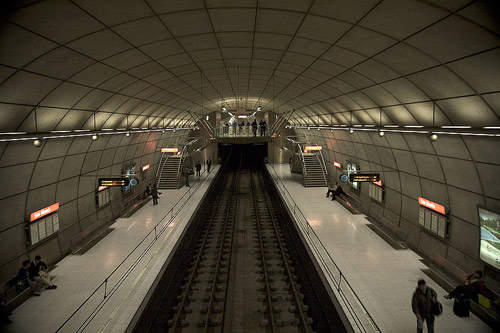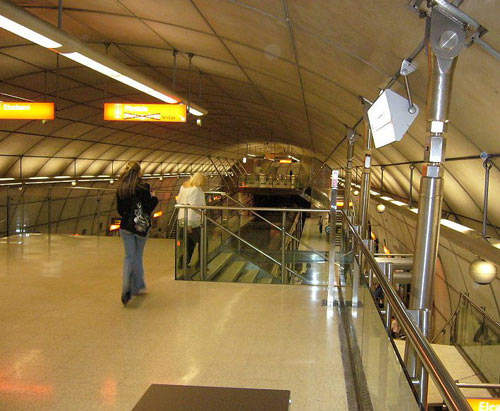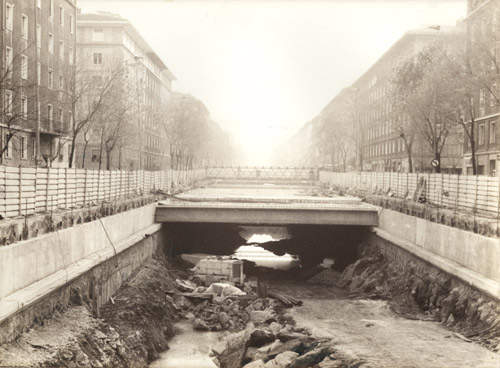A rapid transit railway underground network, the Bilbao Metro is owned and operated by Basque-based Biscay Transport Consortium (CTB). CTB uses a meter-gauge network for the Bilbao Metro. The network is completely underground.
The Bilbao Metro project was originally proposed in the early 1920s. The financial crisis and the Spanish Civil War, however, led to the termination of the project. In 1976 Bilbao City Council and the Commerce Bureau established the CTB for developing the metro. In 1987 the Basque Government approved a construction plan for the project, which was financed by the government.
About 87 million passengers used the Bilbao Metro each year. Ridership drastically increased between 1998 to 2002, as the network was expanded. The ridership is expected to reach 100 million passengers a year after completion of the entire network in 2013.
Routes
The Bilbao Metro currently operates two lines, Line 1 and Line 2. Line 1 connects Etxebarri to Plentzia, while Line 2 connects Etxebarri to Santurtzi. An extension is planned from Santutzi to new station Kabiezes, and is scheduled to open in 2012.The Bilbao Metro is broadly categorised into three zones: Zone A, Zone B and Zone C.
The intermediate stations on Line 1 are Bolueta, Basarrate, Santutxu, Casco Viejo, Abando, Moyua, Indautxu, San Mames, Deusto, Sarriko, San Inazio, Lutxana, Astrabudva, Leioa, Lamiako, Areeta, Gobela, Neguri, Aiboa, Algorta, Bidezabal, Ibarbengoa, Berango, Larrabasterra, Sopelana and Urduliz .
The intermediate stations on Line 2 are Bolueta, Basarrate, Santutxu, Casco Viejo, Abando, Moyua, Indautxu, San Mames, Deusto, Sarriko, San Inazio, Gurutzeta / Cruces, Ansio, Barakaldo, Bagatza, Urbinaga, Sestao, Abatxolo, Portugalete, Penota and Santurtzi stations.
Line 2 passes along a route similar to that of Line 1 until San Inazio, where it deviates towards the south to reach Santurtzi.
Zone A connects stations from Bolueta to San Inazio, while Zone B links Lutxana to Berango in Line 1 and Lutxana to Santurtzi in Line 2. Upon completion the two lines together will span about 40.6km and have 41 stations.
A third line, Line 3, will connect Etxebarri and Matiko and run parallel to the Lines 1 and 2. The 5.9km line will have eight stations, passing throughSan Antonio, Otxarkoaga, Txurdinaga, Zurbaranbarri, Casco Viejo and Uribarri
Project
The main aim of building the metro was to ease congestion in Bilbao. The initial contract for the underground metro design was awarded to Sir Norman Foster and Partners in 1988. The same year the first underground station in Line 1 opened to the public.
The first stage of Line 1, encompassing 23 stations from Casco Viejo and Plentzia, was inaugurated in November 1995. Four more stations, Santutxu, Basarrate, Bolueta and Gobela, were added in July 1997. The construction of the main Moyua Square station, which began in 1989, was completed in 1997.
With the inauguration of Etxebarri station along Line 1 in January 2005, the total number of stations on the line reached 29. Ariz station was opened in November 2011. A new station at Ibarbengoa-Getxo (municipality of Getxo) is expected to open by 2012.
Five new stations in Line 2, Gurutzeta-Cruces, Ansio, Barakaldo, Bagatza and Urbinaga, opened in April 2002. Sesato along Line 2 was inaugurated along with Etxebarri station in January 2005. The line was further extended to Portugalete, adding two more stations, Abatxolo and Portugulete, in January 2007.
Another two stations, Penota and Santurtzi, were added to Line 2 in July 2009. Kabiezes station, which is under construction along Line 2, will open in January 2012.
The Line 3 project is estimated to cost €185m ($251.8m). It is being funded equally by the Basque Government and the Provincial Council of Bizkaia. Construction of Line 3 began in 2009 and is expected to be completed by 2013. It has a scope for extension in the future.
Infrastructure
All Bilbao Metro stations include glass structures. Large caverns were dug for the stations, creating open spaces. Steel and concrete mezzanine structures were built over the tracks, while lifts and escalators provide access to trains.
Stations are also equipped with public address systems, ticket machines and warning buzzers and lights on trains. They also feature signs with contrasting colours to make reading them easier and Braille signs in lifts.
Rolling stock
Bilbao Metro uses three types of cars: UT-500, UT-600 and UT-550, all of which are manufactured by CAF. Currently 24 UT-500 cars and 13 UT-550 cars are operating in the Bilbao Metro. The cars are maintained and parked in Sopelana and Ariz stations.
The UT-500 and UT-550 cars are equipped with state-of-the-art systems. Motor carriages in the cars improve power, acceleration and braking. Welded stainless steel was used in the development of the railcars.
Although both types of railcar appear similar, the UT-550 series has more features than the UT-500. They include a new air conditioning systems, advanced soundproofing and handgrips. The UT-550 also features an information display system (IDS). The IDS is directly connected to the central control desk.
Elastic wheels in all bogies of the railcars reduce noise. The railcars also feature an automated wheel lubrication mechanism, allowing them to run smoothly over various sections of the track. The railcars can travel at 80kmph.
An automatic train protection (ATP) system and automatic train operation (ATO) system were introduced in 1998.
Signalling and communication
In June 2008 Bilbao’s Consorcio de Transportes de Bizkaia awarded a contract to technology provider Thales to design, implement and maintain its supervisory control and data acquisition (SCADA) solution.
Bilbao Metro’s four remote command centres, train traffic management, electro-mechanical control facilities at stations, energy usage, passenger communication and security are managed by Thales.
The future
A proposed fourth line (Line 4), which will connect Moyúa and Rekalde stations, is under study. It is planned that it will have six stations. A fifth line (Line 5), which will run between Etxebarri and Galdakao stations, is also under consideration. The project study is expected to be completed by 2012.






